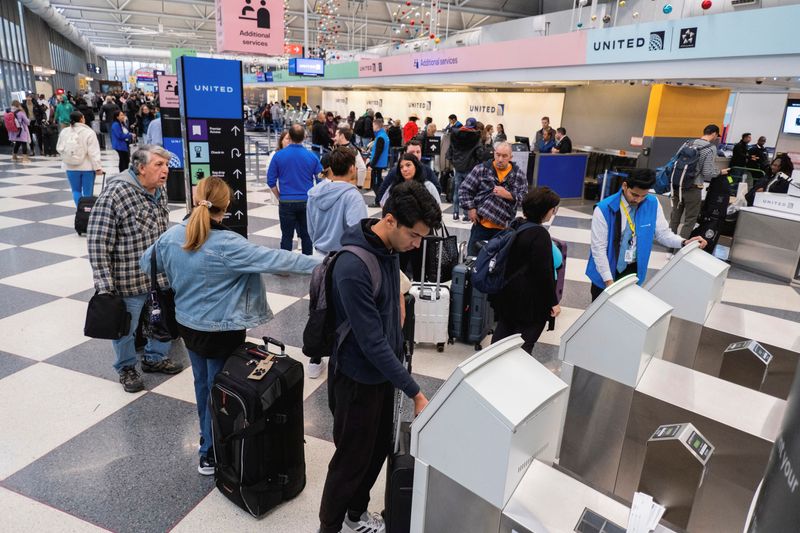Higher services costs lift US producer inflation in October

By Lucia Mutikani
WASHINGTON (Reuters) -U.S. producer prices picked up in October, lifted by higher costs for services like portfolio management and airline fares, more evidence that progress towards lower inflation was stalling.
The report from the Labor Department on Thursday followed on the heels of news on Wednesday that consumer inflation had barely budged last month. The data did not change views the Federal Reserve would deliver a third interest rate cut next month, but left economists expecting firmer readings in the personal consumption expenditures (PCE) price indexes in October.
The U.S. central bank tracks the PCE price measures for its 2% inflation target. Combined with the weekly jobless claims report on Thursday that suggested the abrupt slowdown in job growth in October was an aberration, and looming tariffs on imported goods from President-elect Donald Trump’s administration, economists said the Fed was likely to opt for fewer rate cuts next year than currently anticipated.
“The price data released this week suggest that inflationary pressures are proving stronger than the Fed anticipated,” said Stephen Brown, deputy chief North America economist at Capital Economics.
The producer price index for final demand rose 0.2% last month after an upwardly revised 0.1% gain in September, the Labor Department’s Bureau of Labor Statistics said. The increase in the PPI was in line with economists’ expectations. The PPI was previously reported to have been unchanged in September.
In the 12 months through October, the PPI increased 2.4% after advancing 1.9% in September.
Services prices rose 0.3% after gaining 0.2% in September. A 3.6% surge in portfolio management fees accounted for more than a third of the rise in services costs. Airline fares jumped 3.2% after rising 1.1% in the prior month.
The cost of hospital outpatient care rose 0.6% after being unchanged in September. But hospital inpatient care prices fell 0.4%. There were also increases in the prices of vehicle wholesaling, computer hardware, software and supplies retailing as well as cable and satellite subscriber services.
The government introduced new-model-year passenger cars and light motor trucks prices with the October PPI report. Wholesale goods prices rebounded 0.1% after falling 0.2% in September.
Food prices dropped 0.2% while the cost of energy goods slipped 0.3%.
Portfolio management fees, healthcare, hotel and motel accommodation and airline fares are among components that go into the calculation of the personal consumption expenditures (PCE) price index, excluding food and energy.
The so-called core PCE inflation is one of the measures tracked by the Federal Reserve for its 2% target.
The government reported on Wednesday that consumer prices increased 0.2% in October for the fourth straight month, while a measure of underlying inflation gained 0.3% for the third consecutive month.
The narrower measure of PPI, which strips out food, energy and trade, rose 0.3% after edging up 0.1% in September. The so-called core PPI increased 3.5% year-on-year after rising 3.3% in September.
Following PPI data economists raised their estimates for the October core PCE price index increase to a 0.28% to 0.32 range. That was up from the 0.2% to 0.26% range after the CPI data.
Core inflation gained 0.3% in September. It was forecast rising 2.8% year-on-year in October after increasing 2.7% in each of the prior three months.
U.S. stocks were lower. The dollar rose against a basket of currencies. U.S. Treasury prices were little changed.
JOBLESS CLAIMS FALL
Financial markets saw a roughly 79.1% probability of a 25 basis points rate cut at the Fed’s Dec. 17-18 policy meeting, according to CME Group’s FedWatch Tool. The odds of rates being unchanged were at about 20.9%.
Policymakers are keeping a wary eye on the labor market, which has shown signs of significant softening amid tepid hiring. But the latest weekly jobless claims data suggested the labor market continued to chug along in early November.
Initial claims for state unemployment benefits dropped 4,000 to a seasonally adjusted 217,000 for the week ended Nov. 9, the Labor Department said in another report. Economists polled by Reuters had forecast 223,000 claims for the latest week.
Claims surged in early October amid distortions from Hurricanes Helene and Milton as well as a strike by factory workers at Boeing, but layoffs have remained historically low, which is underpinning the economy.
Though it might take some time for the areas devastated by Helene to recover, economists are optimistic that job growth will regain steam in November also as the Boeing strike ended, allowing the planemaker to scrap rolling furloughs it had implemented to conserve cash. Nonfarm payrolls increased by a mere 12,000 jobs in October, the fewest in nearly four years.
The U.S. central bank last week cut its benchmark overnight interest rate by 25 basis points to the 4.50%-4.75% range.
The Fed initiated its policy easing cycle with an unusually large half-percentage-point rate cut in September, the first reduction in borrowing costs since 2020. It hiked rates by 525 basis points in 2022 and 2023 to tame inflation.
The number of people receiving benefits after an initial week of aid, a proxy for hiring, decreased 11,000 to a seasonally adjusted 1.873 million during the week ending Nov. 2, the claims report showed. The decline in the so-called continuing claims likely reflected the end of Boeing-related furloughs and waning disruptions from the hurricanes.
(Reporting by Lucia Mutikani; Editing by Andrea Ricci)